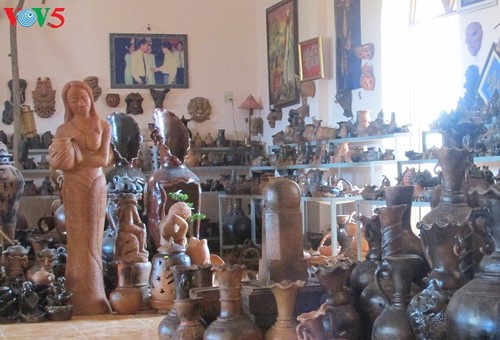 Bau Truc pottery products. (Photo: Ai Nghiem, Hanipha/VOV) Bau Truc pottery products. (Photo: Ai Nghiem, Hanipha/VOV) |
The Cham in the southern region have 9 craft villages, 4 of them famous for weaving and pottery, the traditional Cham handicrafts.
These 4 villages are hundreds of years old. They are Bau Truc pottery village in Ninh Thuan, Binh Duc pottery village in Binh Thuan, My Nghiep weaving village in Ninh Thuan, and Tan Chau silk weaving village in An Giang.
Nguyen Huu Phuoc, Deputy Representative of the Vietnam Craft Villages Association in Ho Chi Minh City, said: “We must handle the conflict between Cham efforts to preserve their culture and market trends affecting their traditional products. Although their products are handicraft items, several steps can be automated to turn out more sophisticated products. To preserve the cultural identity of each region, more policies, for example on price subsidies, are needed to help producers maintain profits.”
The current problem faced by Cham craft villages is that their production is on a small scale, mainly by households whose marketing capacity is limited and unprofessional. To address the situation, some Cham craft villages have set up cooperatives and a closed system from production to consumption. Product designs have been diversified and renewed regularly.
Doctor Phu Van Han, Cham culture researcher and Deputy Director of the Southern Institute of Social Sciences, said: “The preservation of traditional craft villages should be linked to the Cham culture which is widely known for weaving and pottery. We should find ways to preserve the villages immediately, otherwise they will fall into oblivion.”
 Loom machines at My Nghiep weaving village in Ninh Thuan. (Photo: Ai Nghiem, Hanipha/VOV) Loom machines at My Nghiep weaving village in Ninh Thuan. (Photo: Ai Nghiem, Hanipha/VOV) |
Ho Si Son, Deputy Director of Ninh Thuan’s Department of Culture, Sports, and Tourism, said: “We often promote craft villages through tourism websites and connect them with travel agents. Craft villages themselves should create more products that can satisfy tourists and offer art programs.”
Say Mah, an artisan in brocade weaving in Tan Chau town, An Giang province, underscored the need to change the current vocational training method.
“As an artisan, I think we should help the younger generation understand the artistic and cultural values of traditional crafts. Artisans should recognize who can be trained to follow the crafts and pass down to them,” Say Mah added.
To help Cham craft villages develop, hundreds of thousands of USD have been invested in infrastructure, vocational training, and product promotion.